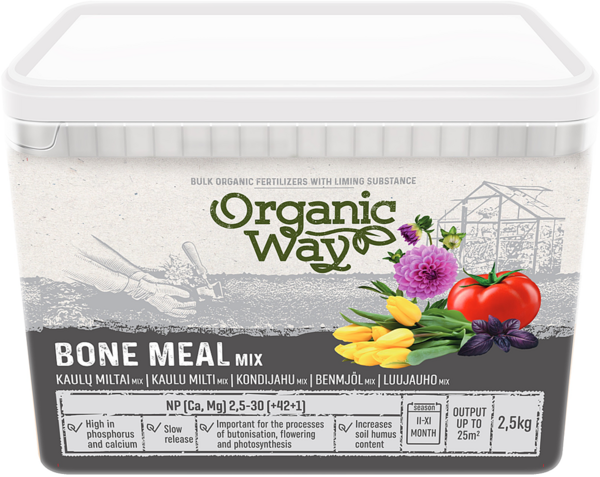Fertilizer for soil improvement and feeding of various types of plants. Avoid fertilizing acid-loving plants, soils with phosphorus deficiency and soils with a pH of 7 or higher.
The fertilizer is a mixture of slowly releasing nutrients that provides a long-term effect.
It takes 4 to 6 months for the material to be fully absorbed.
Always try to apply it locally on site and work it into the soil to a depth of 25 cm. It is recommended to water the soil before and after applying bone meal.
Fertilize around shrubs and trees along the width of the crown of the branches. Apply the recommended amount 1-2 times.
The amount of fertilizer applied depends on the vegetative needs of the plants, the timing of application and the nutrient content of the soil.
Bone meal can be used from February to November (almost all year round), but it is best used in early spring before planting and in autumn after harvesting.
Consumption rates.
Seedling nursery - 300 g / m2;
Rooting seedlings - 30-50 g / per plant (place 1-2 tablespoons of the product in the hole and mix thoroughly with the soil);
Open ground beds and greenhouse soil (top dressing) - 150-300 g / m2;
Vegetables and potatoes - 70-100 g / m2;
Plants grown in pots and containers (indoor, balcony, potted and terrace flowers - flowering plants) - 30 g / 1 l with the preparation of a nutrient medium;
Outdoor flowers and flowering shrubs, ornamental plants - 150-200 g/m2;
Hedges of ornamental plants - 200 g/m2;
Fruit and landscape trees - 150-300 g/m2;
Lawns (at establishment) - 150 g/m2, vegetating lawns - 300 g/m2.
The component is suitable for use as a fertilizer in a mixture based on an assessment of climatic and soil conditions.
Аttention: feeding of farm animals is permitted 21 days after the application of this fertilizer to plants.
(Contains a sufficient minimum proportion of CAS No 1317-65-3 to avoid possible use of the mixture for feed purposes in accordance with good agricultural practice).
How to feed plants with bone meal?
In dry form (for light and loose soils).
If the flour is used in dry form, it is first sprayed in an even layer over a pre-moistened area. Then it is embedded in the soil. After that, the soil is watered generously again.
In dissolved form (for heavy soils): dilute 500 g of bone meal in 10 liters of water.
Immediately after dilution, it is better not to water the soil - let this solution sit for 5-7 days so that the maximum amount of nutrients passes from the dry powder into the water. Then this solution is diluted with water at a ratio of 1:19 and used for root feeding.
The feeding can be combined with ash: wood ash contains up to 5% potassium, and bone meal - up to 15% phosphorus.
* One of the main advantages of bone meal is the duration of its action: it decomposes in the soil for 4-8 months, due to which nutrients reach the roots of plants and are completely absorbed by them gradually. As a result, crop yields increase.
* Bone meal brings the greatest benefit to plants planted on acidified soils. Such a soil composition helps to more quickly absorb substances from bone fertilizer.
* Bone meal is irreplaceable in the production of compost, as it contains a large amount of phosphorus and potassium, which are lacking in plant residues.
* In terms of nutritional value, bone meal is between superphosphate and phosphate rock among phosphorus fertilizers.
* Bone meal helps to strengthen the root system of plants and their immunity. Therefore, it is added to the soil before planting. Seedlings with it take root faster and develop better. Bulbous plants germinate faster and are better anchored in the soil.
* Vegetables grown on bone meal do not accumulate nitrates
* Bone meal helps fruit trees recover after abundant fruiting. The phosphorus contained in the fertilizer is also necessary for them to set buds for the next year and successfully overwinter.
* Bone meal is better absorbed in combination with nitrogen fertilizers, and when composting - with peat or manure.












